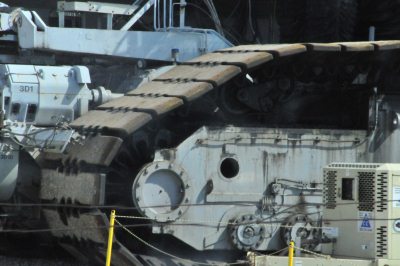The Crawlers

|
Crawler-transporter
 A crawler-transporter carrying Discovery
travels the ramp to Launch
Pad 39B. The vehicle's back end can be raised, keeping the Shuttle
and the MLP level. Much as I love my favourite MACK Trucks for their distinctive sound,
size and power - I was overwhelmed by these chaps. The crawler-transporters are a pair of tracked
vehicles
used to transport spacecraft
from NASA's
Vehicle
Assembly Building (VAB) along the Crawlerway
to Launch
Complex 39. They were originally used to transport the Saturn
IB and Saturn
V rockets
during the Apollo,
Skylab
and Apollo–Soyuz
programs. They are currently used to transport the Space
Shuttle. The crawler-transporters carry vehicles on the Mobile
Launcher Platform, and after each launch return to the pad to take
the platform back to the VAB. The two crawler-transporters were designed and built by Marion Power Shovel (now Bucyrus International) using components designed and built by Rockwell International at a cost of US$14 million each. They are the largest self powered land vehicles in the world. When they were built, they were the largest tracked vehicles in the world, a title later taken by the German Bagger 288 excavator.
The crawler-transporter carrying the Ares I-X on its test
flight Specifications: The crawler-transporter has a mass of 6,000,000 pounds – has eight tracks, two on each corner. Each track has 57 shoes; each shoe weighs 1,984 pounds. The vehicle measures 131 feet by 114 feet. The height from ground level to the platform is adjustable from 20 feet to 26 feet, and each side can be raised and lowered independently of the other. The crawler uses a laser guidance system and a leveling system to keep the Mobile Launcher Platform level within 10 minutes of arc, while moving up the 5% grade to the launch site. A separate laser docking system provides pinpoint accuracy when the crawler-transporter and Mobile Launch Platform are positioned in the VAB or at the launch pad. A team of nearly 30 engineers, technicians and drivers operate the vehicle.
 The crawler has 16 traction motors, powered by four 1,341 horsepower (1,000 kW) generators, in turn driven by two 2,750 horsepower (2,050 kW) Alco diesel engines. Two 1,006 horsepower (750 kW) generators, driven by two 1,065 horsepower (794 kW) engines, are used for jacking, steering, lighting, and ventilating. Two 201 horsepower (150 kW) generators are also available to power the Mobile Launcher Platform. The crawler's tanks hold 4,200 imperial gallons of diesel fuel, and it burns 125.7 gallons per minute.

Crawlerway junction at the LC-39 observation gantry. The right track leads to pad LC-39A (pictured with the Space Shuttle Endeavour), while the left track leads to pad LC-39B
The crawler is controlled from two control cabs located at either end of
the vehicle, and travels along the 3.5 miles Crawlerway at a maximum speed
of 1 mile per hour loaded, or 2 miles per hour unloaded. The average
trip time from the VAB along the Crawlerway to Launch Complex 39 is about five
hours. Each crawlerway is 7 feet deep and covered with Alabama and
Tennessee river rock for its low friction properties to reduce the possibility
of sparks. In 2000, NASA unearthed and restored an Apollo-era segment of the
crawlerway to provide access to a high-bay building in order to provide
protection from a hurricane. Kennedy Space Center has been using the same two crawlers, nicknamed "Hans" and "Franz" for the bodybuilding characters since their initial delivery in 1965. In their lifetime, they have traveled more than 3,400 miles (5,500 km), about the same driving distance as Miami to Seattle.

The crawlers were overhauled in 2003 with upgrades to the Motor Control Center, which houses the switchgear and electrical controls of all of major systems onboard, a new engine and pump ventilation system and new diesel engine radiators, and replacement of the 2 driver cabs on each vehicle (one on each end). NASA had planned to use crawlers when the Space Shuttle is retired in 2011 and the Ares I and Ares V were to take its place. Due to their age and need to support the heavier Ares V (with its launch umbilical tower), NASA planned to modify the crawler's engines to have the ability to carry the heavier loads envisioned for the Ares V for both its lunar and, later, planetary roles.
 Of course the last picture goes to Bear treating one of the cleats as a cannon
ALL IN ALL A TREAT FOR US BIG MACHINE LOVERS AN AWESOME BIT OF KIT |
